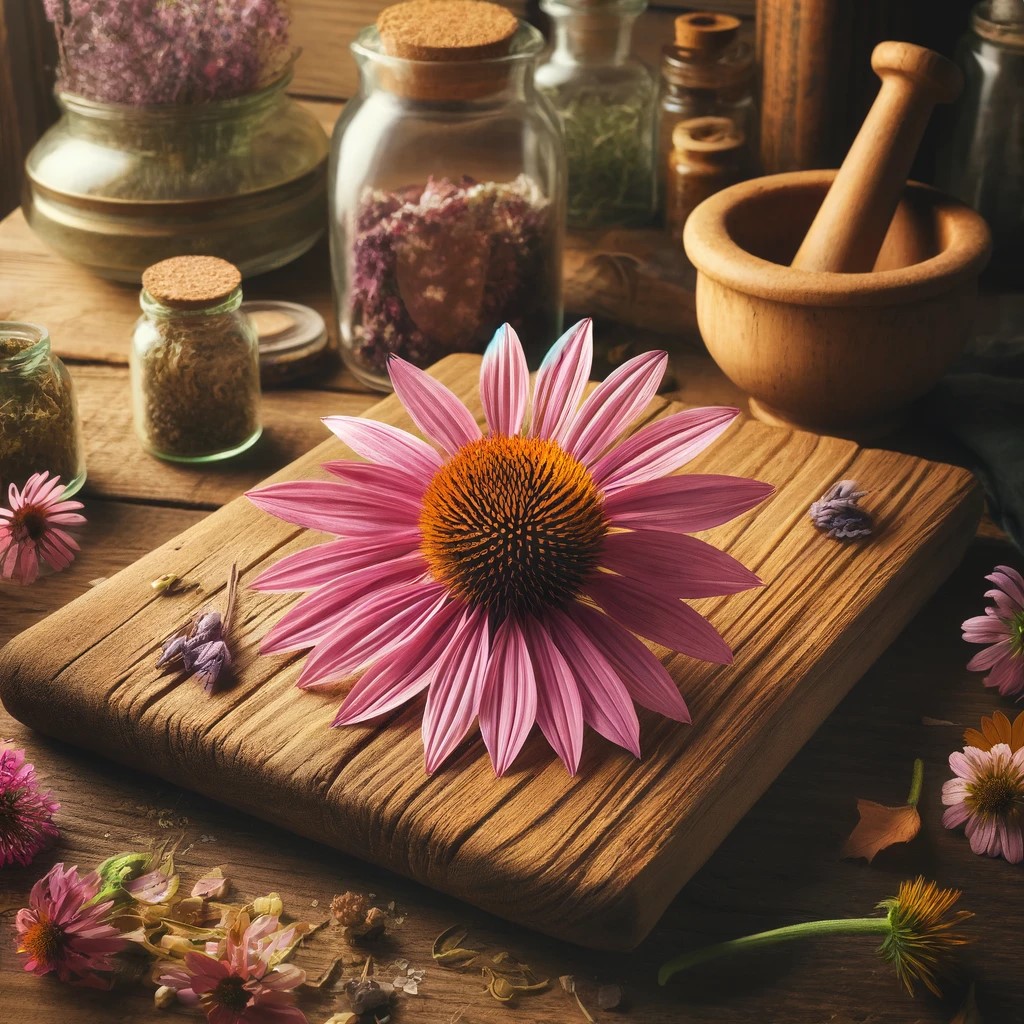This website contains affiliate links for products I use and love. If you take action (i.e. subscribe, make a purchase) after clicking a link, I may earn some tea money, which I promise to drink while creating more helpful content like this.
- Home
- Herb Index
- Echinacea Monograph
The information provided on this website is for educational purposes only, and is not FDA approved. It is not to be considered health advice. Always do your own research and seek the guidance of a qualified healthcare practitioner before working with any herb. Herbal Ella is not liable for any action or inaction you take with the materials and information provided. Read here for more information.
Echinacea Monograph: Benefits, Uses, and Growing Tips | Herbal Remedies Guide

- Common Name: Echinacea, Coneflower
- Latin Name: Echinacea purpurea
- Brief introduction or overview: Echinacea is renowned for its immune-boosting and anti-inflammatory properties, often used to prevent and alleviate colds, flu, and other infections.

Botanical Overview
- Family: Asteraceae (daisy family)
- Identification (physical description): Echinacea features tall stems topped with large, daisy-like flowers, usually with pink to purple petals and a distinctive spiky central cone.
- Parts used medicinally: Roots, leaves, and flowers
- Habitat: Native to North American prairies, widely cultivated in temperate climates.
Herbal Actions
- Primary pharmacological properties: Immunostimulant, anti-inflammatory, antibacterial, antiviral.
Energetic Qualities & Taste
- Energetic properties: Slightly warming and drying.
- Taste: Tongue-tingling, numbing sensation, mildly bitter.
Medicinal Uses
- Specific health conditions the herb addresses: Common cold, flu, upper respiratory infections, and slow-healing wounds.
- How it works in the body: Enhances the immune system's response, reducing inflammation and fighting off infection.
- Synergies: Often combined with herbs like goldenseal and elderberry for enhanced respiratory and immune support.
Culinary Uses
- How the herb is used in cooking: Mostly used for medicinal purposes; however, young Echinacea leaves can be eaten raw or cooked, adding a pungent taste to dishes.
- Flavor profile: Aromatic and slightly bitter, similar to arugula or radish.
Contraindications & Precautions
- Possible side effects: Rare; however, may include allergic reactions, especially in those allergic to other Asteraceae plants.
- Interactions with medications or conditions: Should be used with caution in individuals with autoimmune diseases or those on immunosuppressive medication.
- Special considerations: Generally safe, but due to its immune-stimulating properties, it should be used cautiously in pregnancy and lactation.
Cultivation Tips
- Growing conditions: Prefers full sun and well-drained soil. Drought-tolerant once established.
- Harvesting methods: Roots are typically harvested from plants that are 3-4 years old in the autumn.
Historical Use & Folklore
- Traditional uses: Echinacea, or coneflower, has been a cornerstone in the medicinal practices of various Great Plains indigenous tribes for centuries. It was employed not only for its effectiveness in treating external wounds and infections but also for systemic ailments such as colds and flu. Among the most dramatic uses was its application on snake bites, where it was believed to reduce venom toxicity.
- Indigenous use:
Echinacea held a revered spot in the herbal medicine chest of many Native American tribes, including the Lakota, Cheyenne, Sioux, and Crow. It was often the first remedy turned to for combating various infections and boosting overall immunity. The roots were especially prized and would be chewed or used to make decoctions and poultices.
- Cultural significance:
Beyond its health benefits, Echinacea was deeply woven into the cultural fabric of many tribes. It was considered a sacred plant capable of purifying the body and spirit. During community healing ceremonies, it was common for healers to use Echinacea to prepare the body and spirit to fight illness or recover from physical trauma.
- Folklore and mythological associations:
In folklore, Echinacea was considered a powerful ward against negative forces and illness. It was often used in protective charms and rituals designed to ward off spirits of sickness and malaise. The belief was that its strong spirit could enhance the body's natural defenses and clear negative energy.
- Magical uses/beliefs: The magical uses of Echinacea are closely tied to its health-promoting properties. It was commonly used in amulets or charms intended to strengthen the immune system. Additionally, it was believed to be effective in rituals to cleanse spaces or individuals of negative energy and to promote healing and well-being. By tapping into the powerful history and cultural depth of Echinacea, we can appreciate not only its physical healing properties but also its role in spiritual and protective practices across cultures.
Recipes & Preparation Methods
- Medicinal preparations: Echinacea tea, tinctures, and capsules are common for immune support.
- Culinary recipes: Echinacea petals can be sprinkled over salads or added to cocktails for a hint of color and a boost of nutrients.
Hot Ginger Echinacea Lemon Tea

INGREDIENTS:
- 2 cups boiling water
- 1 teaspoon dried echinacea fresh edible flower (or roots)
- 1 teaspoon finely chopped fresh ginger
- 1 lemon, juice of, freshly squeezed
- 1 teaspoon honey (or more to taste)
DIRECTIONS:
- In a teapot, pour the boiling water over the echinacea and chopped ginger.
- Cover and steep for 10-15 minutes.
- Add lemon juice and honey and stir to mix. Strain and pour into 2 mugs.
- Serve warm and enjoy!
Recent Articles
-
Wild Cherry Monograph: Wild Cherry: Nature's Respiratory Ally
May 02, 24 04:52 PM
Discover the healing potential of Wild Cherry with our comprehensive monograph. Explore its benefits and uses for respiratory health. -
DIY Herbal Remedies for Respiratory Health
May 02, 24 03:46 PM
Explore easy DIY herbal remedies for respiratory health with Herbal Ella. Learn to make teas, tinctures, and more to breathe better naturally -
Understanding the Respiratory System - Anatomy and Functions
May 02, 24 03:23 PM
Discover the respiratory system's anatomy and functions with clear visuals and simple explanations to keep you breathing healthily
* Privacy Policy * Disclaimer *










